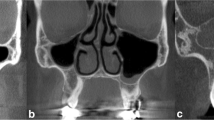Abstract
The goal of this study was to determine whether frontal sinus hypoplasia coexists with maxillary sinus hypoplasia. Analyzing paranasal CT scans retrospectively, we included 86 patients who had a hypoplastic maxillary sinus at least on one side and 80 patients with bilateral normal maxillary sinuses (control group). We classified hypoplastic maxillary sinuses using the classification system previously defined by Bolger et al. (Otolaryngol Head Neck Surg 103(5):759–765, 1990). We classified the frontal sinuses as aplastic, hypoplastic, medium-sized, and hyperplastic; as previously defined by Guerram et al. (Am J Phys Anthropol 154(4):621–627, 2014). We compared the presence of frontal sinus hypoplasia using Chi-square test between the groups. The mean age of the maxillary sinus group was 43.2 (range 18–84) years. Of 86 patients, 33 (38.4%) had unilateral and 53 (61.6%) had bilateral maxillary sinus hypoplasia. Of 139 maxillary sinuses totally included, 73 (52.5%) were type 1, 51 (36.7%) were type 2 and 15 (10.8%) were type 3 hypoplastic maxillary sinuses. Of 332 frontal sinuses totally included, 25 (7.5%) were aplastic, 32 (9.6%) were hypoplastic, 172 (51.9%) were medium-sized, and 103 (31%) were hyperplastic. Of 86 patients with a hypoplastic maxillary sinus at least on one side, 29 (33.7%) had a hypoplastic and/or aplastic frontal sinus, while 10 (12.5%) had a hypoplastic and/or aplastic frontal sinus at least on one side in control group. Incidence of frontal sinus hypoplasia and/or aplasia was significantly higher in patients with maxillary sinus hypoplasia compared to the patients with bilaterally normal maxillary sinuses (χ2 = 10.384, P = 0.001). Maxillary sinus hypoplasia has a significantly higher coexistence with frontal sinus hypoplasia. This study may have an implication for anatomical studies about the development of the paranasal sinuses and paranasal sinus surgery as well as further morphological studies.


Similar content being viewed by others
References
Eggesbo HB, Sovik S, Dolvik S, Eiklid K, Kolmannskog F (2001) CT characterization of developmental variations of the paranasal sinuses in cystic fibrosis. Acta Radiol (Stockholm: 1987) 42(5):482–493
Khanduri S, Singh N, Bhadury S, Ansari AA, Chaudhary M (2015) Combined aplasia of frontal and sphenoid sinuses with hypoplasia of ethmoid and maxillary sinuses. Indian J Otolaryngol Head Neck Surg 67(4):434–437. https://doi.org/10.1007/s12070-015-0877-9
Guerram A, Le Minor JM, Renger S, Bierry G (2014) Brief communication: the size of the human frontal sinuses in adults presenting complete persistence of the metopic suture. Am J Phys Anthropol 154(4):621–627. https://doi.org/10.1002/ajpa.22532
Bolger WE, Woodruff WW Jr, Morehead J, Parsons DS (1990) Maxillary sinus hypoplasia: classification and description of associated uncinate process hypoplasia. Otolaryngol Head Neck Surg 103(5):759–765. https://doi.org/10.1177/019459989010300516
Guven DG, Yilmaz S, Ulus S, Subasi B (2010) Combined aplasia of sphenoid, frontal, and maxillary sinuses accompanied by ethmoid sinus hypoplasia. J Craniofac Surg 21(5):1431–1433. https://doi.org/10.1097/SCS.0b013e3181ecc2d9
Kandogan T, Dalgic A, Mollamehmetoglu H, Esen O (2013) Combined aplasia of sphenoid, frontal, and maxillary sinuses with hypoplasia of the ethmoid sinus. Iran Red Crescent Med J 15(1):13–14. https://doi.org/10.5812/ircmj.2627
Liu T, Dong Z, Zhang N, Li J (2013) The maxillary sinus morphology that affect the vision of nasal endoscopy in maxillary sinus surgery. Lin Chung Er Bi Yan Hou Tou Jing Wai Ke Za Zhi 27(23):1293–1295
Bornstein MM, Seiffert C, Maestre-Ferrin L, Fodich I, Jacobs R, Buser D, von Arx T (2016) An analysis of frequency, morphology, and locations of maxillary sinus septa using cone beam computed tomography. Int J Oral Maxillofac Implants 31(2):280–287. https://doi.org/10.11607/jomi.4188
Lawson W, Patel ZM, Lin FY (2008) The development and pathologic processes that influence maxillary sinus pneumatization. Anat Rec (Hoboken) 291(11):1554–1563. https://doi.org/10.1002/ar.20774
Tasar M, Cankal F, Bozlar U, Hidir Y, Saglam M, Ors F (2007) Bilateral maxillary sinus hypoplasia and aplasia: radiological and clinical findings. Dento Maxillofac Radiol 36(7):412–415. https://doi.org/10.1259/dmfr/72395885
Bassiouny A, Newlands WJ, Ali H, Zaki Y (1982) Maxillary sinus hypoplasia and superior orbital fissure asymmetry. Laryngoscope 92(4):441–448
Karmody CS, Carter B, Vincent ME (1977) Developmental anomalies of the maxillary sinus. Trans Sect Otolaryngol Am Acad Ophthalmol Otolaryngol 84(4 Pt 1):Orl-723-728
Selcuk A, Ozcan KM, Akdogan O, Bilal N, Dere H (2008) Variations of maxillary sinus and accompanying anatomical and pathological structures. J Craniofac Surg 19(1):159–164. https://doi.org/10.1097/scs.0b013e3181577b01
Sirikci A, Bayazit Y, Gumusburun E, Bayram M, Kanlikana M (2000) A new approach to the classification of maxillary sinus hypoplasia with relevant clinical implications. Surg Radiol Anat 22(5–6):243–247
Yuksel Aslier NG, Karabay N, Zeybek G, Keskinoglu P, Kiray A, Sutay S, Ecevit MC (2016) The classification of frontal sinus pneumatization patterns by CT-based volumetry. Surg Radiol Anat 38(8):923–930. https://doi.org/10.1007/s00276-016-1644-7
Cakur B, Sumbullu MA, Durna NB (2011) Aplasia and agenesis of the frontal sinus in Turkish individuals: a retrospective study using dental volumetric tomography. Int J Med Sci 8(3):278–282
Koertvelyessy T (1972) Relationships between the frontal sinus and climatic conditions: a skeletal approach to cold adaptation. Am J Phys Anthropol 37(2):161–172. https://doi.org/10.1002/ajpa.1330370202
Author information
Authors and Affiliations
Contributions
KMO: designed study, supervised study, and wrote article. ÖH: collected and analyzed data, made statistics, and wrote article. ZAS: analyzed data and revised article. HU: analyzed data and revised article. GY: analyzed data and revised article.
Corresponding author
Ethics declarations
Conflict of interest
The authors declare that there is no conflict of interest.
Ethical statement
This retrospective study was conducted using paranasal CT archive and article does not contain any studies with human participants or animals performed by any of the authors.
Additional information
This work has been presented at the 4th Congress of European ORL-HNS-Cornerstones in European ORL-HNS, Barcelona, Spain.
Rights and permissions
About this article
Cite this article
Ozcan, K.M., Hizli, O., Sarisoy, Z.A. et al. Coexistence of frontal sinus hypoplasia with maxillary sinus hypoplasia: a radiological study. Eur Arch Otorhinolaryngol 275, 931–935 (2018). https://doi.org/10.1007/s00405-018-4892-9
Received:
Accepted:
Published:
Issue Date:
DOI: https://doi.org/10.1007/s00405-018-4892-9




